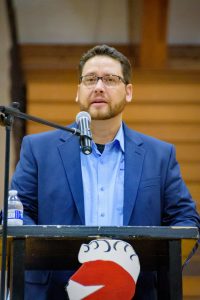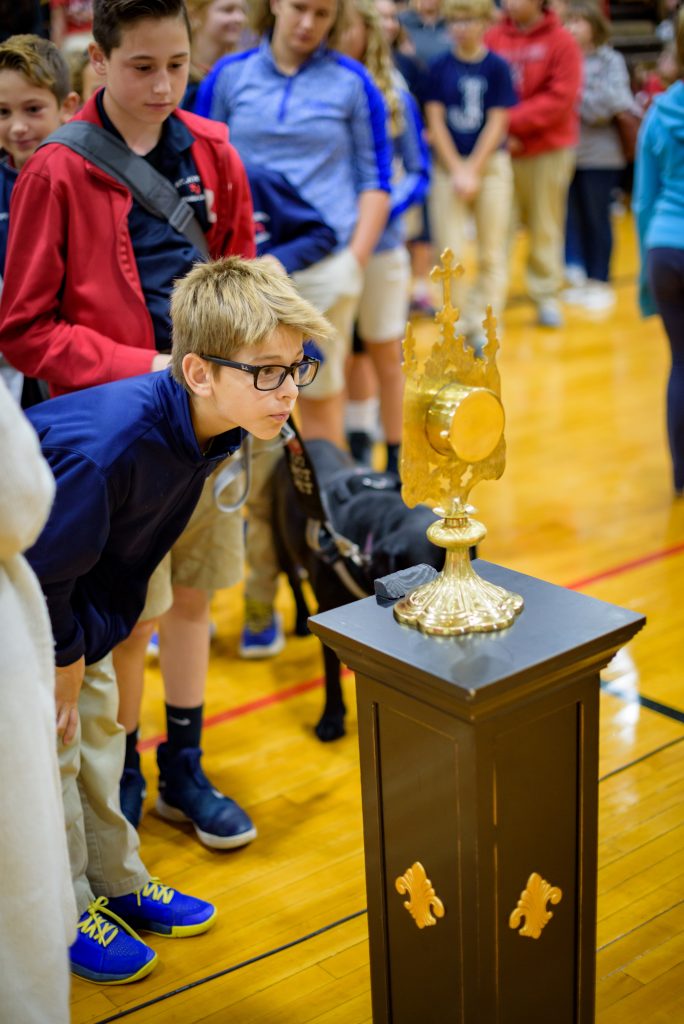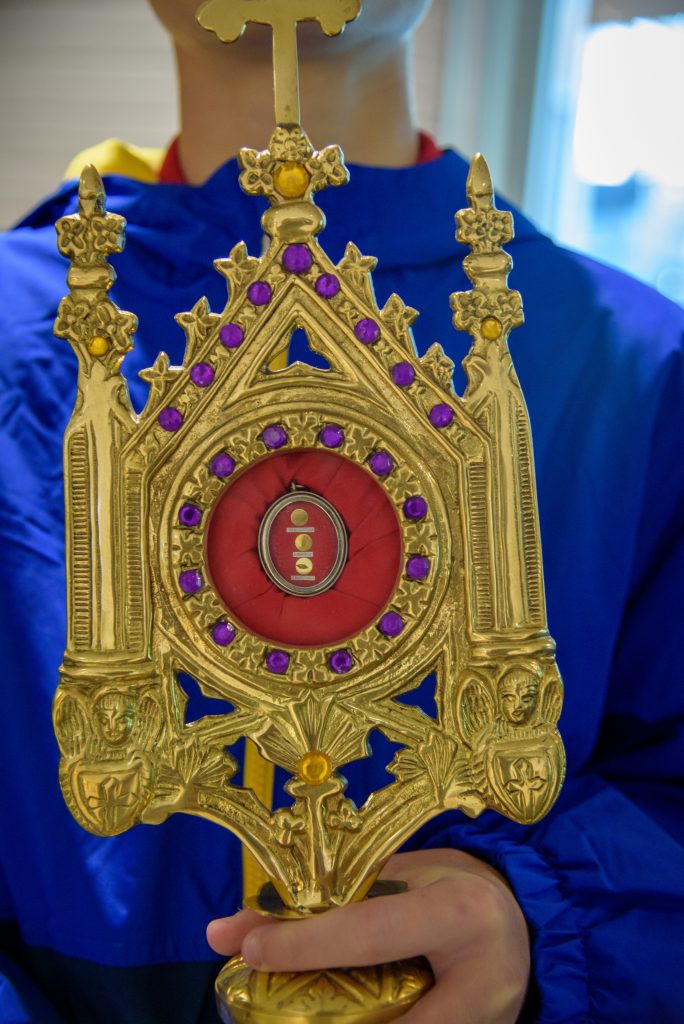October 12, 2019 // Diocese
First-class Fatima relics visit high schools
At the encouragement of the Vatican, Fatima Family Apostolate was founded by the late Father Robert J. Fox. Prior to his death, Father Fox chose John C. Preiss to carry on his work because of his knowledge of family life and his love for Mary.
Click here for more photos from this event.
Preiss, president of Fatima Family Apostolate International, visited the four diocesan high schools to speak on devotion to Our Lady of Fatima. On Oct. 3 he spoke with the students of Saint Joseph High School, South Bend, and Marian High School, Mishawaka; Oct. 4 he began his day at Bishop Luers High School, followed by Bishop Dwenger High School, both in Fort Wayne.
Anita Senesac, a representative from the World Apostolate of Fatima Diocese of Fort Wayne-South Bend division, said Preiss is an adult convert to the Catholic faith, husband and father of eight with another child on the way. He is the editor of the Immaculate Heart Messenger magazine, has been interviewed on Catholic Radio and Vatican Radio, has hosted the Family Matters radio program and appeared on the EWTN Bookmark and the At Home with Jim and Joy television program. He is the author of “Our Lady of Fatima: True Devotion” and a children’s book titled “The Miracle of the Dancing Sun at Fatima.” His latest Amazon best-seller is called “The Miracle and the Message 100 Years of Fatima.”
Preiss travels from his home in Alabama to promote the Apostolate’s mission to help learn, live and spread the message of Our Lady of Fatima – a call for families to return to holiness.
 Form spiritual life before adulthood
Form spiritual life before adulthood
The Bishop Luers assembly welcomed Preiss by signing “God is Here.” Following his introduction, Preiss noted that the really exciting part of visiting Indiana is getting to witness the Catholic presence.
“Where we are in Alabama, there’s only a 5% Catholic population, so it’s very exciting to see the Spirit here. It gives me a lot of hope when I see that,” he shared.
Preiss joked about his favorite high school days having been Fridays, when there was a guest speaker, no matter the topic — because he got out of class. All joking aside, he asked the students to “really listen to this message, because this message of Fatima is something that is very important for all of us; it’s a way of life.”
“There’s challenges that you’ll face in life as you grow older, when you go to college or you go to work or get married. You always face challenges, and if you form your spiritual life before those challenges come to you, then it will be a lot easier to go through,” he told the students.
He chronicled the Fatima message, which started in 1916 when an angel appeared to three Portugese shepherd children — Jacinta, Francisco and Lucia — and taught them to pray this way: “My God, I believe, I adore, I hope, and I love thee. I beg pardon for those who do not believe, do not adore, do not hope and do not love thee.” This first apparition confirms our faith, Preiss said. The second apparition of the angel was more about the need to pray as a sacrifice of daily life in offering for the sake of our brothers and sisters in Christ.
The third apparition of the angel was the most important of the whole message of Fatima, he said, because the children received their first holy Communion. Preiss told the crowd that the children received divine graces, but everyone who receives Communion can receive the same graces. He reminded them of the importance, prior to receiving the Eucharist, of opening one’s heart, using that moment to petition God and remembering the full presence, the true body and blood of the Lord Jesus Christ. He asked the students to consider how reverent they are to the Lord in that moment.
The apparitions of the angel prepared the children for the apparitions of Mary, which began on May 13, 1917. Mary, Preiss said, appeared to the children six times and asked them to pray the rosary every time. He continued by encouraging students to follow that message and get into the habit of praying the rosary as part of their spiritual journey.
Mary, through her apparitions, also established a devotion to her immaculate heart. She gave the children a vision of hell, confirmed the existence of purgatory, and promised a miracle for the last apparition in October.
On Oct. 13, 1917, it is documented that between 70,000 and 100,000 people witnessed the miracle of the dancing sun.
“This is not just a fairy tale; this is a true story,” Preiss said, encouraging students to look up photos of the event.
After reiterating that his was just the basic story of the message of Fatima, Preiss concluded with the importance of living the message.
“How do you live this in your life?” he asked. “It’s just what Our Lady asked us.” He said this would include praying the rosary every day, wearing the brown scapular as a sign of belonging to Mary and living the First Saturday Devotion of celebrating a First Saturday Mass and adoration, going to confession and praying a rosary. “This is our faith,” Preiss said.

St. Joseph – Hessen Cassel student Michael Smith peers at a relic of Our Lady of Fatima Oct. 4. John Preiss, president of Fatima Family Apostolate International, spoke with Catholic school students in the diocese about the apparition of Mary at Fatima, Portugal, to three shepherd children, and brought with him several relics for veneration. — Nate Proulx
In addition to hearing the message of Fatima, students were given the opportunity to venerate before first-class relics of Jacinta and Francisco and the holm-oak tree above which Mary appeared to the children.
Prior to veneration, the Luers students learned that upon approaching the relic, they could also touch a scapular or medal to it and that item would become a third-class relic of saints Jacinta and Francisco. Principal James Huth requested that each student who touched the relic say a Hail Mary afterward. “I prayed to the saints, that they would pray for me,” said sophomore Jason Haiflich. “I just felt like they were there praying with me in heaven.”
Veneration of relics in the Catholic Church
The Church has always treated the relics of saints in a special manner, preserving them and often putting them on display to be seen by the faithful.
A simple way to venerate a relic is to spend a few minutes in quiet devotion, showing honor and respect to the saint by performing a gesture such as a kneeling, performing the sign of the cross, or praying for intercession. These expressions are indicative of one’s commitment to live the Catholic faith and strive for sainthood.
However, one should not genuflect in the same way as is done before the Blessed Sacrament. Only Christ should be venerated this way. Whichever way a person chooses to venerate a relic, it should not be done out of superstition; it is a reverence to the saint and love of God.
The best news. Delivered to your inbox.
Subscribe to our mailing list today.







